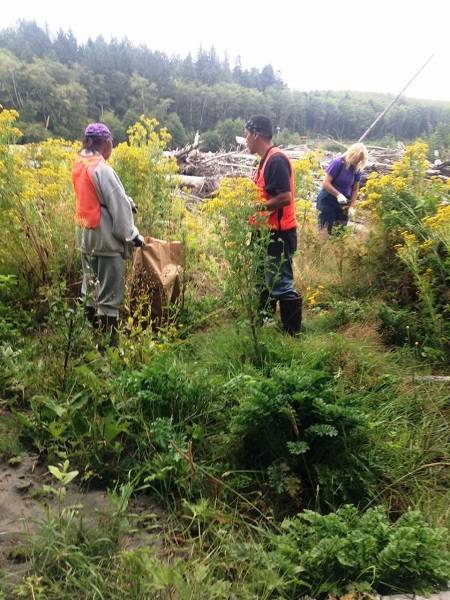From Mora Road repairs to U.S. Highway 101 maintenance along Lake Crescent to the Sol Duc bridges’ repainting, there’s been a lot of road work this summer.
You’ve probably driven by some quiet crews, too, clipping yellow-flowered weeds and stuffing them in yard waste bags.
These men and women work for the 10,000 Years Institute (10KYI), an Olympic Peninsula-based nonprofit organization creating jobs in the restoration of forests, rivers, wetlands and estuaries on the Olympic Coast.
People access many of these waters and landscapes by roads and invasive, non-native plants move on these pathways, too. The roads’ open, disturbed habitat creates an easy route for the seeds of these sun-loving generalist species, which spread quickly via mowers, vehicles, wind and water.
Three yellow-flowered plants from Europe and Asia — tansy ragwort, Scotch broom and St. John’s wort — are among the most aggressive. All three outcompete native plants, harm wildlife habitat and degrade working forests or farms.
10KYI and partners across the peninsula have been dealing with Scotch broom and tansy ragwort for years, but St. John’s wort is the newest concern for the Olympic Coast.
So far it’s cropped up in only a few roadside places throughout western Clallam, Jefferson and Grays Harbor counties, making it an excellent candidate for early detection and rapid response (EDRR) management. Successful EDRR programs save money, time, resources and effort because they find, map and control invasive plants before they become overwhelming infestations. The old phrase “nip it in the bud” is precisely why 10KYI crews are on the road.
In groups of 2-5, 10KYI crews drive with eyes alert for 1-3 foot plants crowned with clusters of star-like yellow flowers. Summer roadsides can be a sea of yellow, so crews are trained to see the spindly shape as much as color.
At each sighting, the driver seeks a safe turnout or shoulder as crews ready the tools needed for treatment: scissors for clipping off the flowers, bags to put the flowers in, a tablet to map the plants and biodegradable red tape to flag the location for future monitoring.
Up close, St. John’s wort can be distinguished by dark, purplish dots on its leaves, which are toxic when touched or digested by humans or other animals. That is why the crew wears gloves and why they want to ensure no cow, horse, elk or deer has to suffer from a taste of the toxins. The flowers are clipped because that’s where each plant produces its seeds, which are each roughly the size of a pinhead. The plants are then pulled, trying to get all roots, and broken to stop growth.
At 100,000 seeds per St. John’s wort, 250,000 per tansy ragwort and 12,000 per Scotch broom, these crews are deterring thousands of invasive plants per day. Citizens from Mora to Quinault are also crucial invasive plant observers and pullers, and their efforts really add up in the areas they work on.
By eliminating the sources of non-native plants on the Olympic Coast, this repair work protects the health of people, plants and animals in our community. This work is already supported by your state tax dollars, but the crew also is grateful for every time you slow down for the weed crew ahead.
10KYI will be offering workshops this fall to teach safe, effective treatment and disposal techniques. To get started, explore these invasive plants at the Washington State Noxious Weed Control Board website (http://www.nwcb.wa.gov/), and reporting sightings to 10KYI’s director Jill Silver (jsilver@10000yearsinstitute.org or 360-301-4306).
It only takes one invasive plant to start an invasion, so every plant counts!


